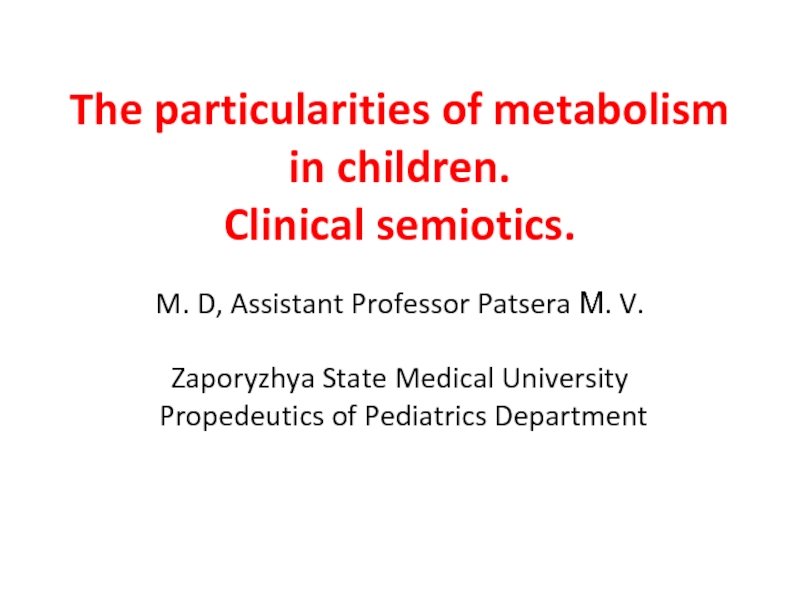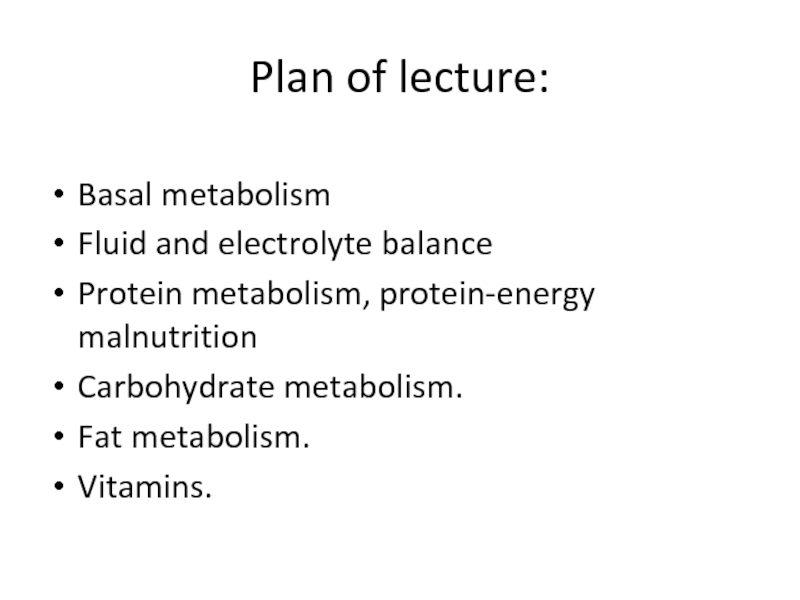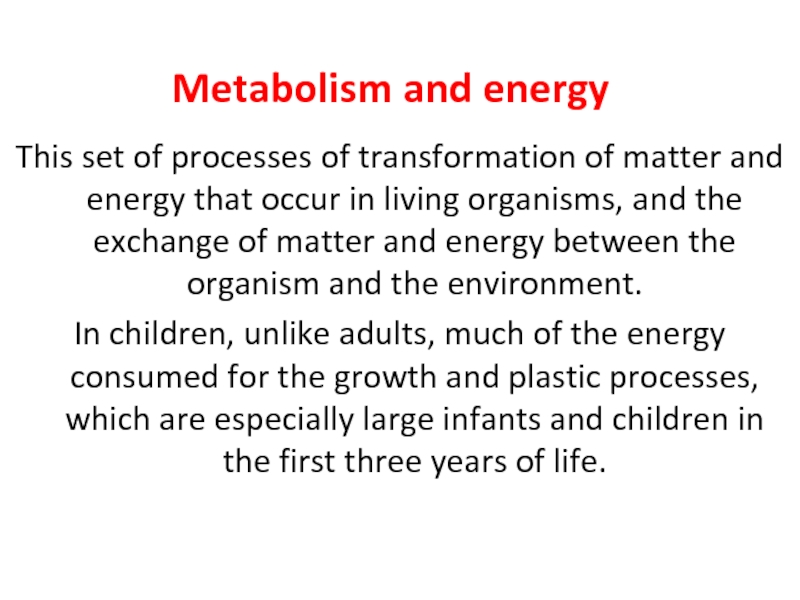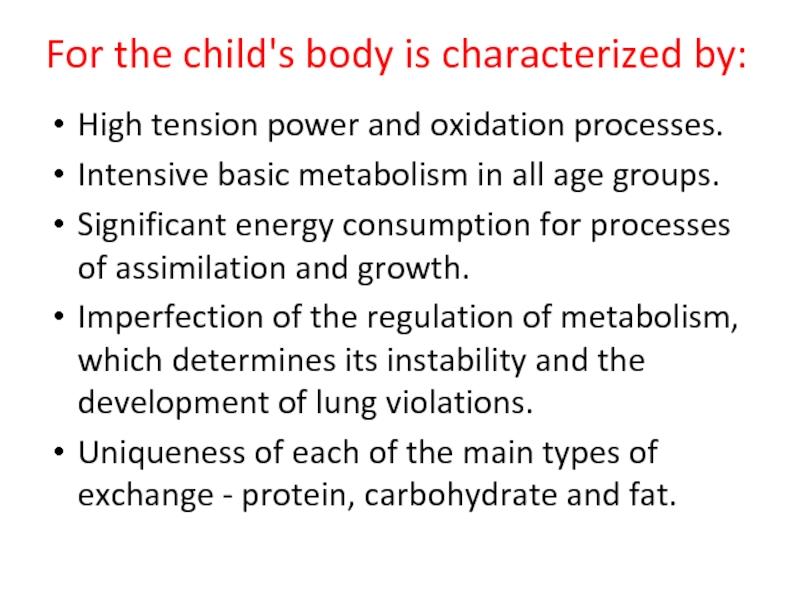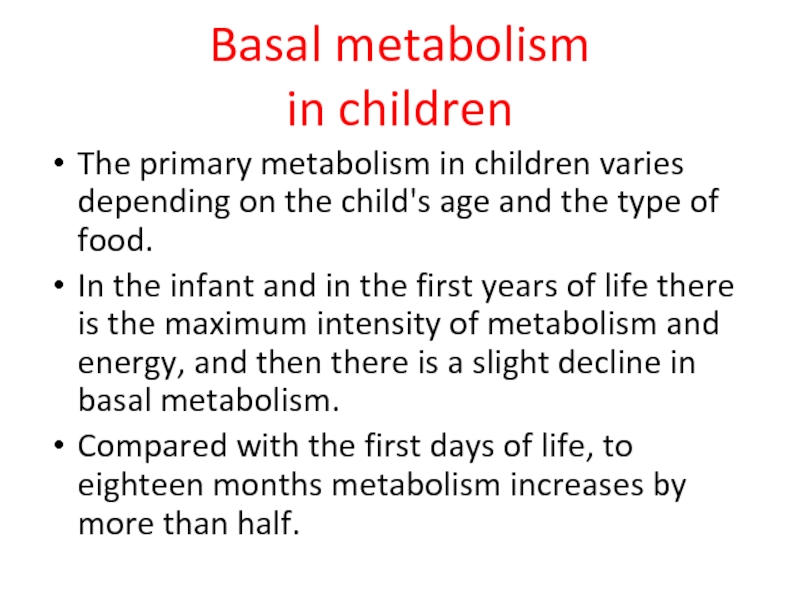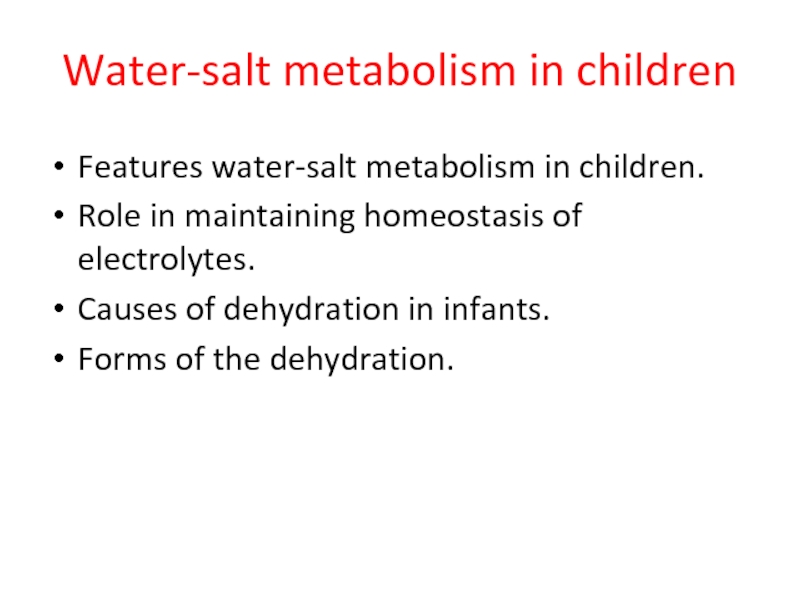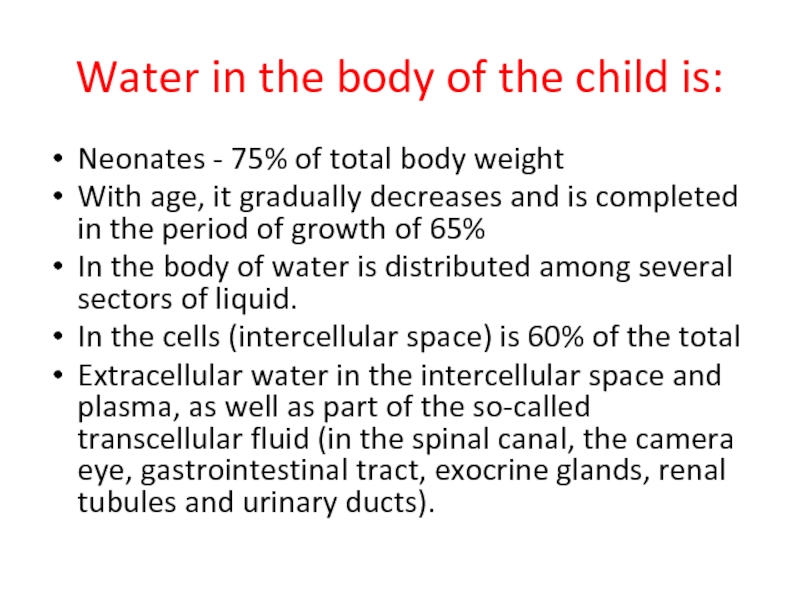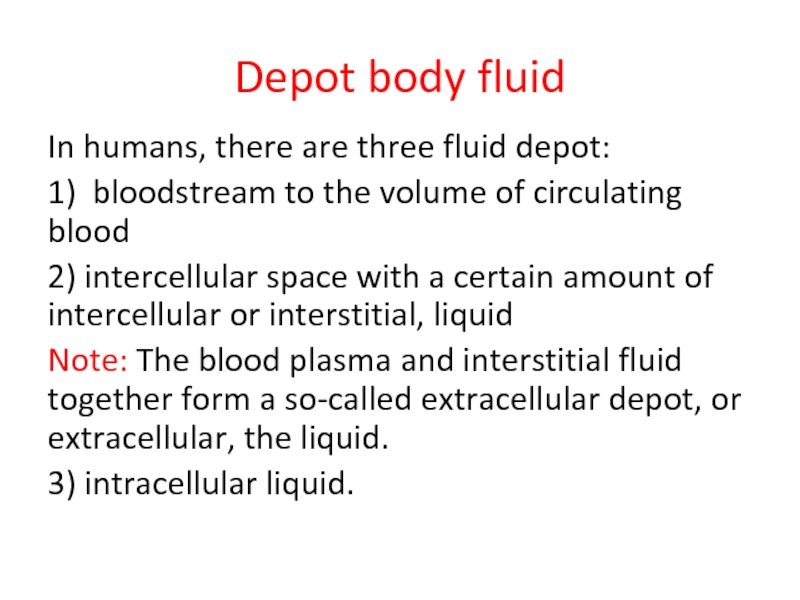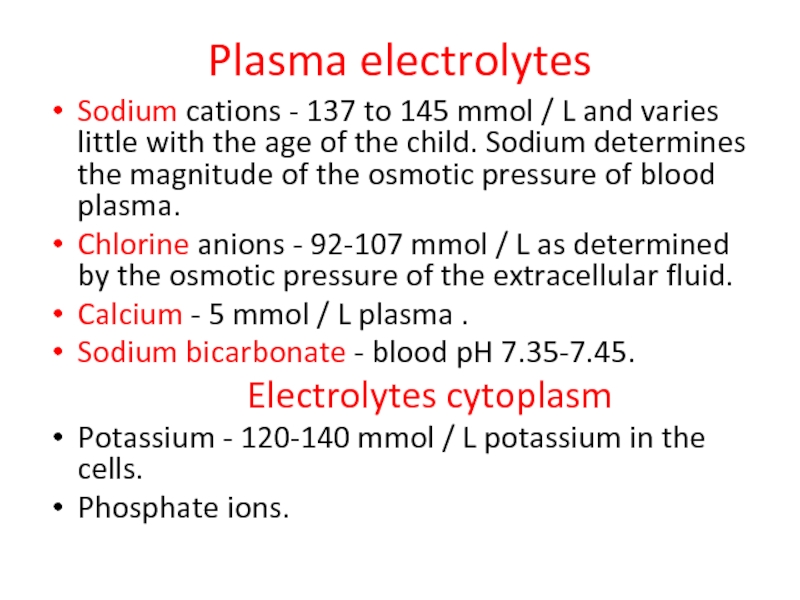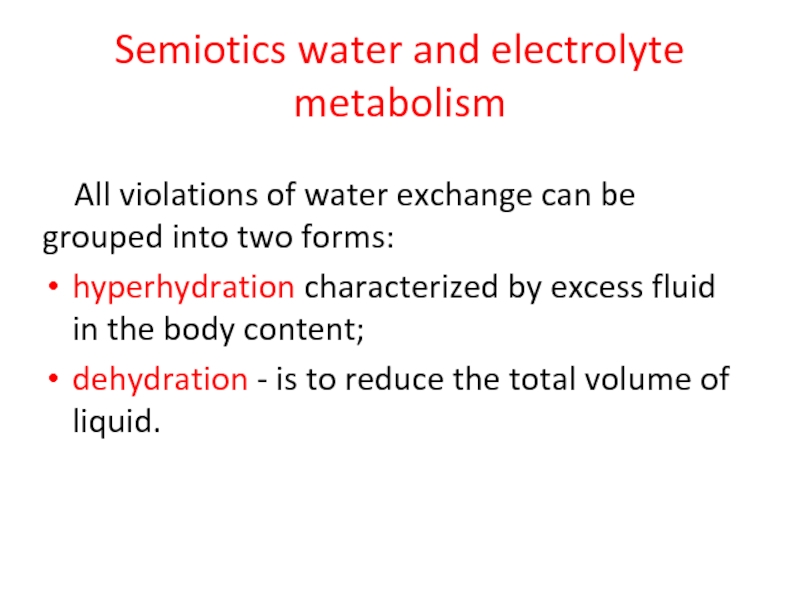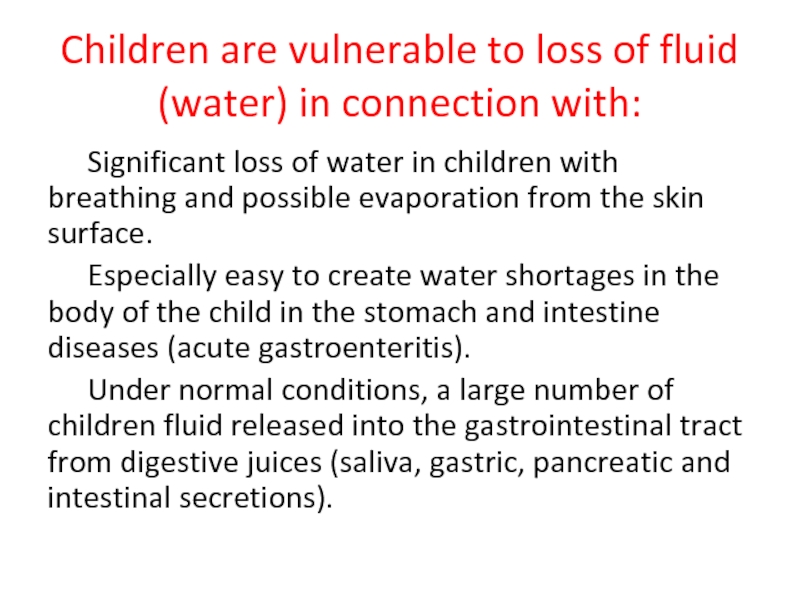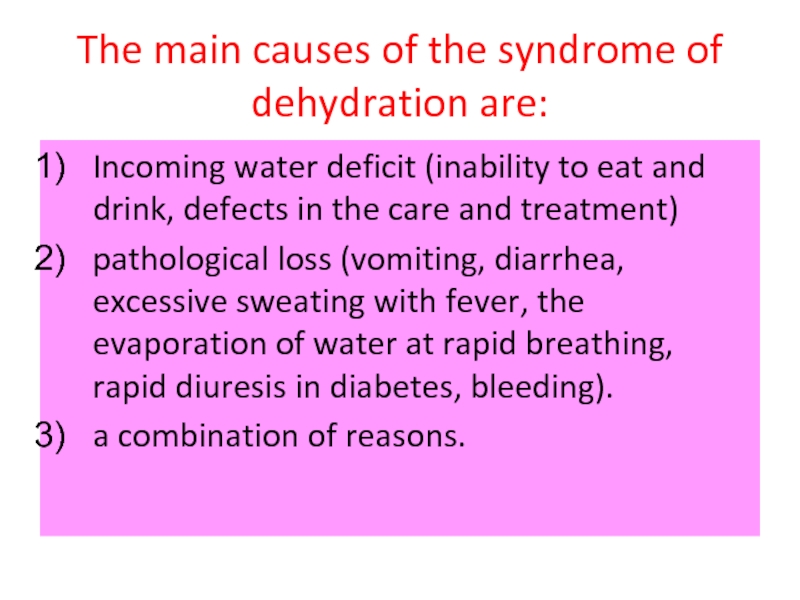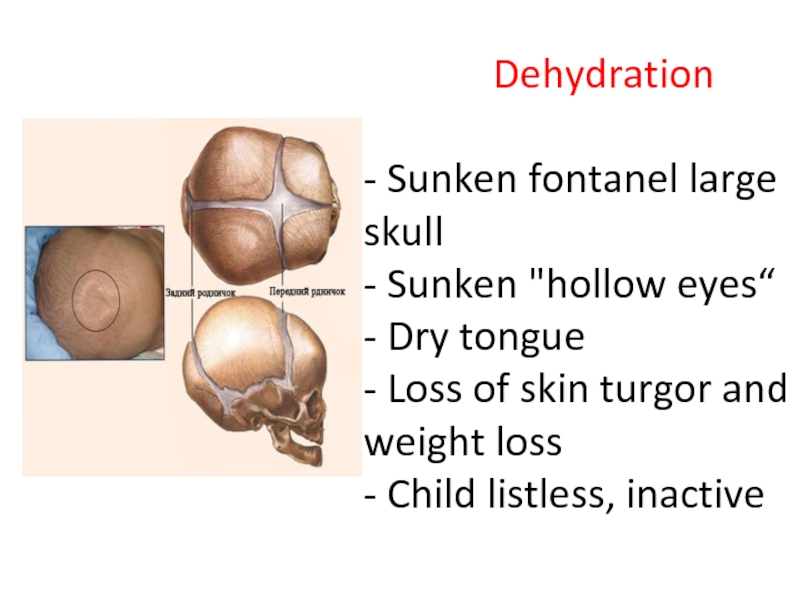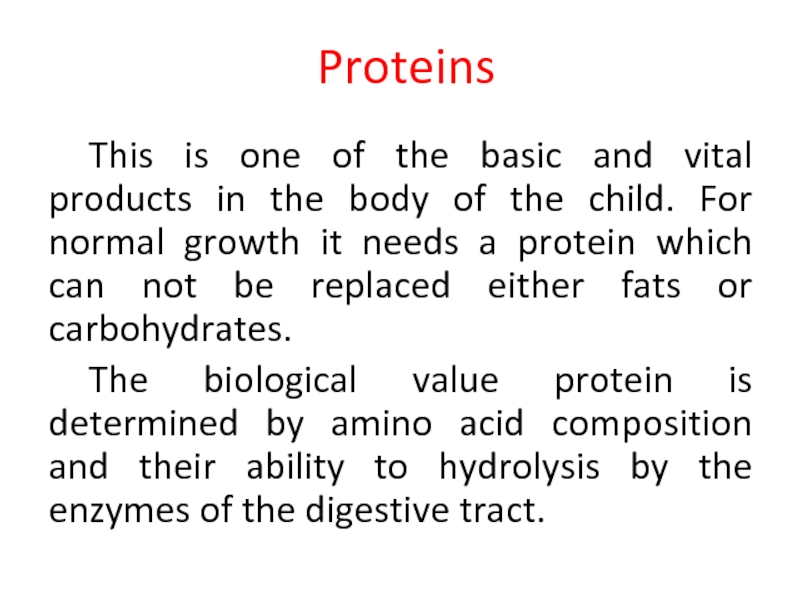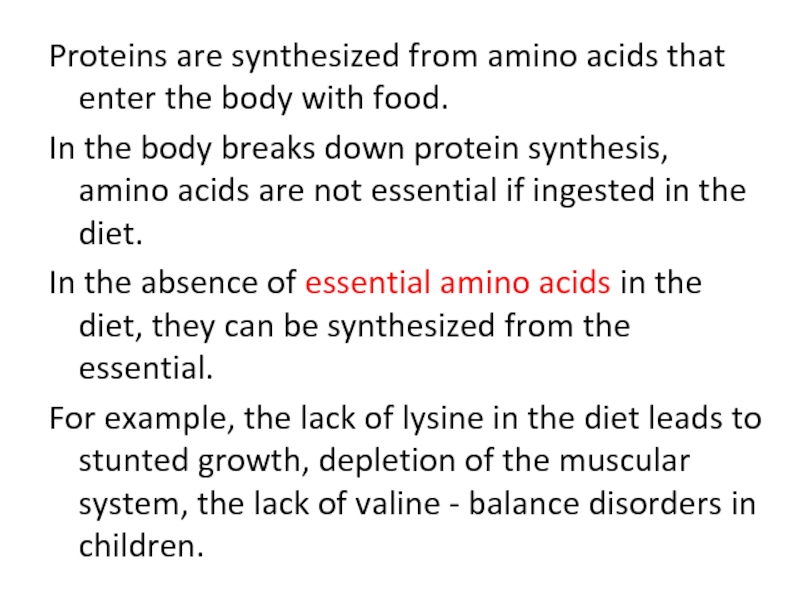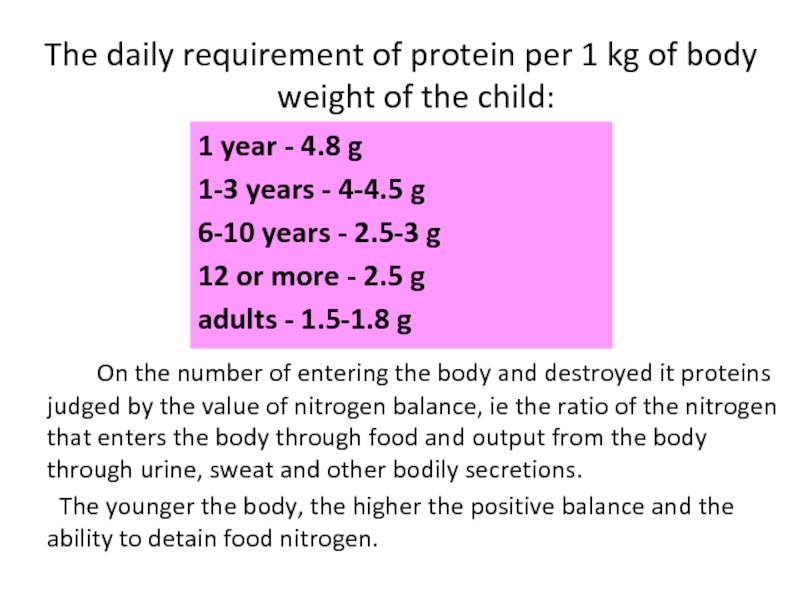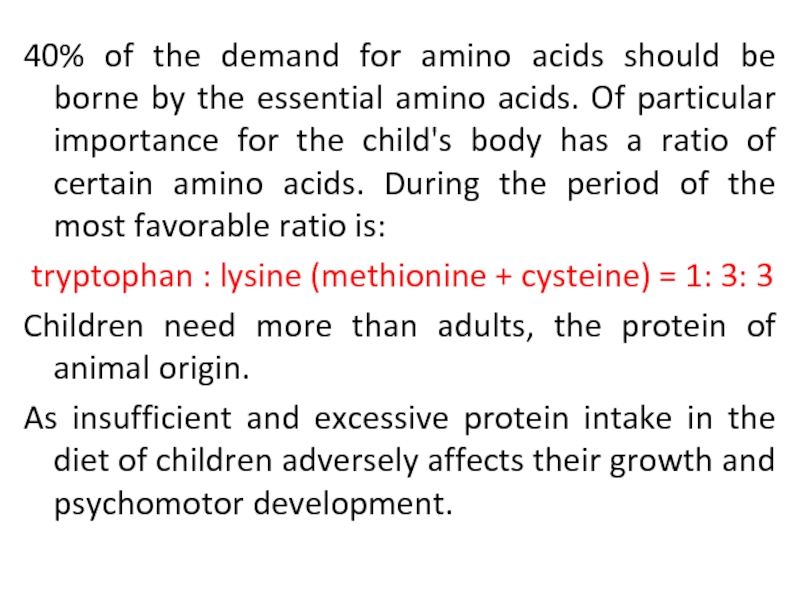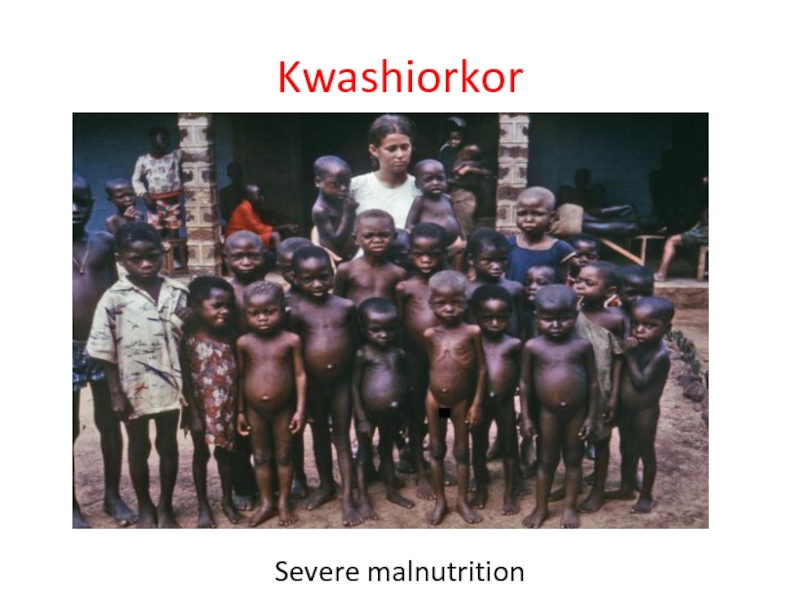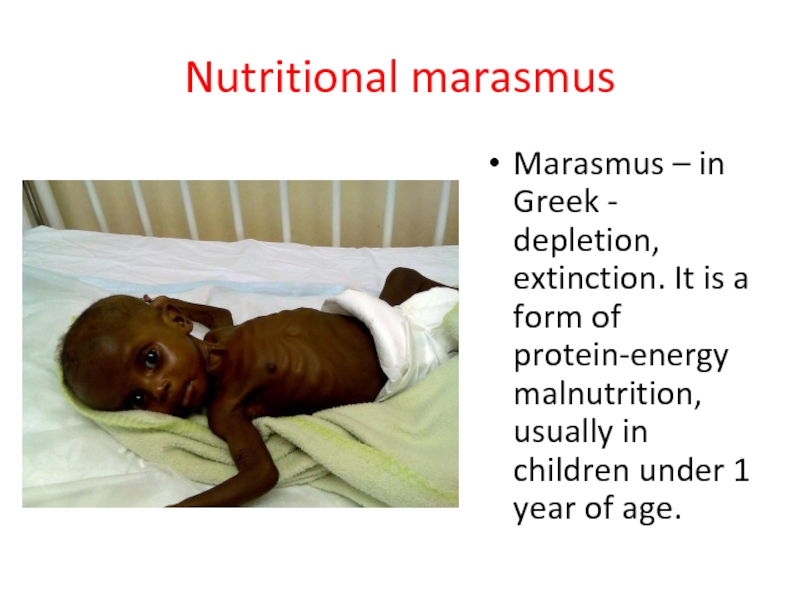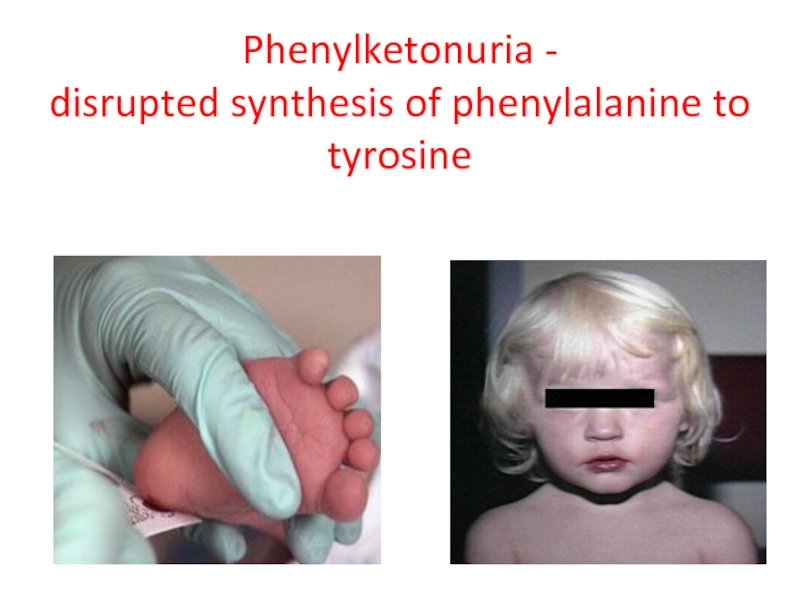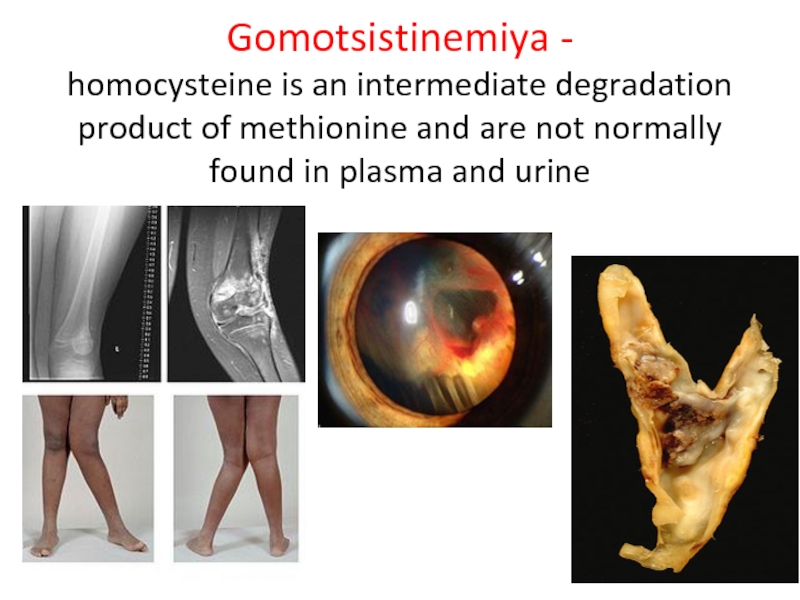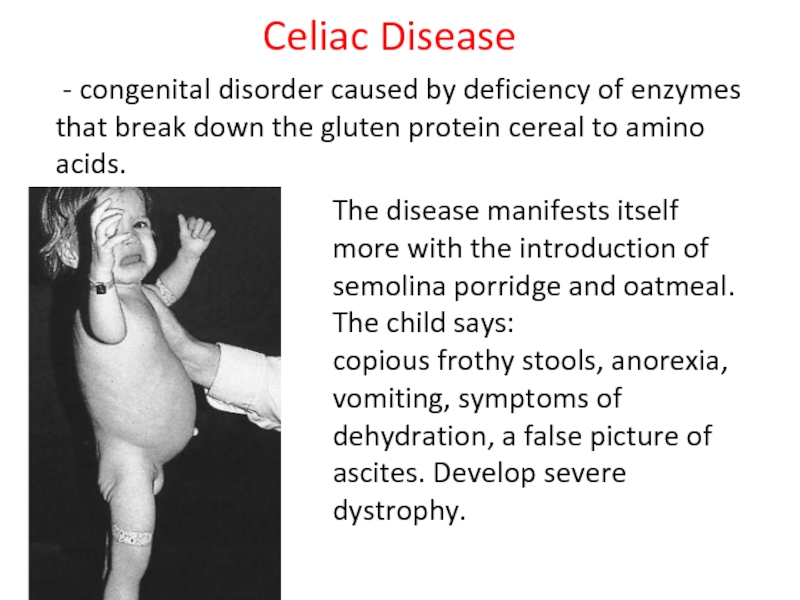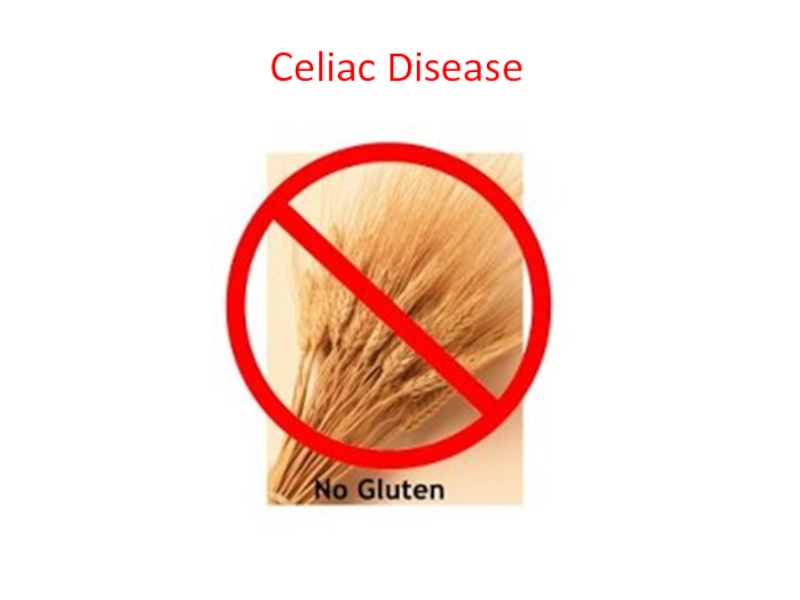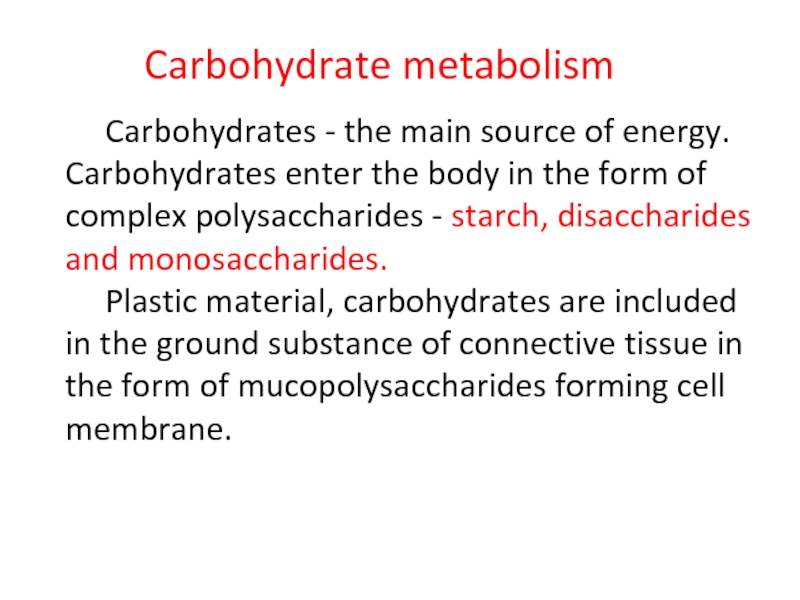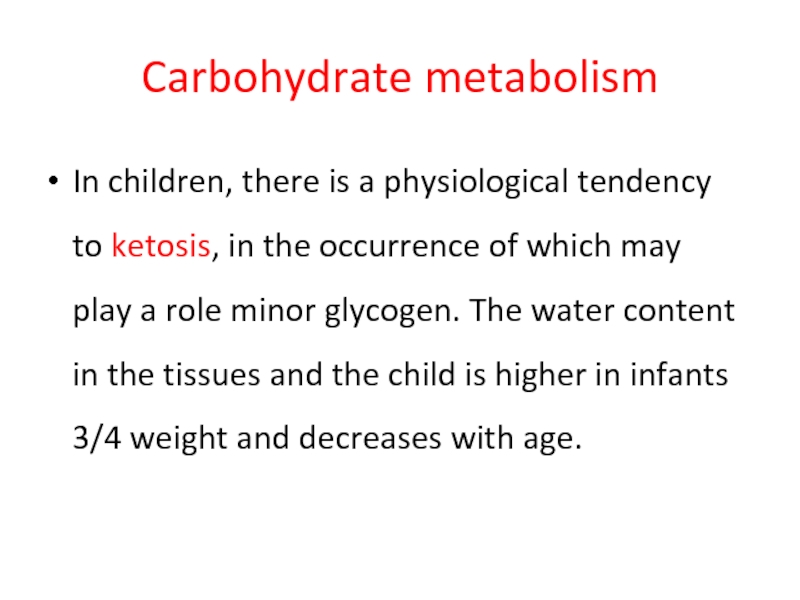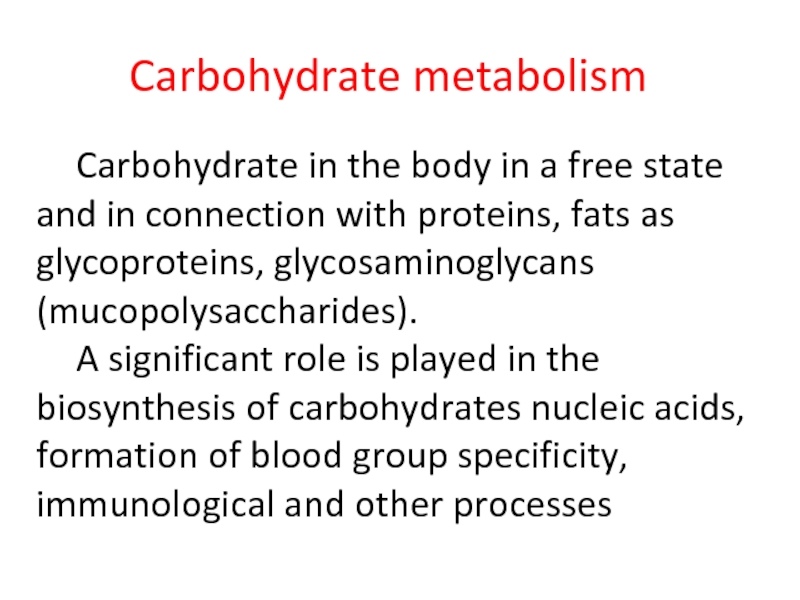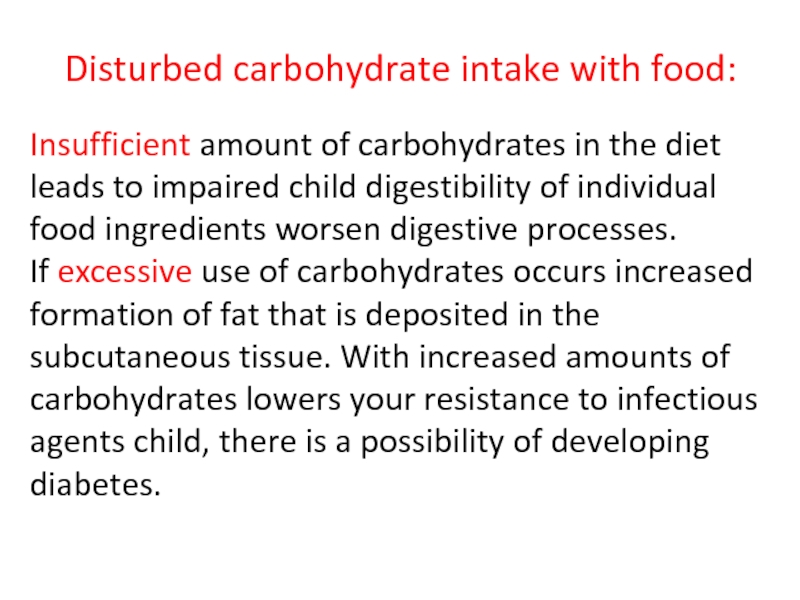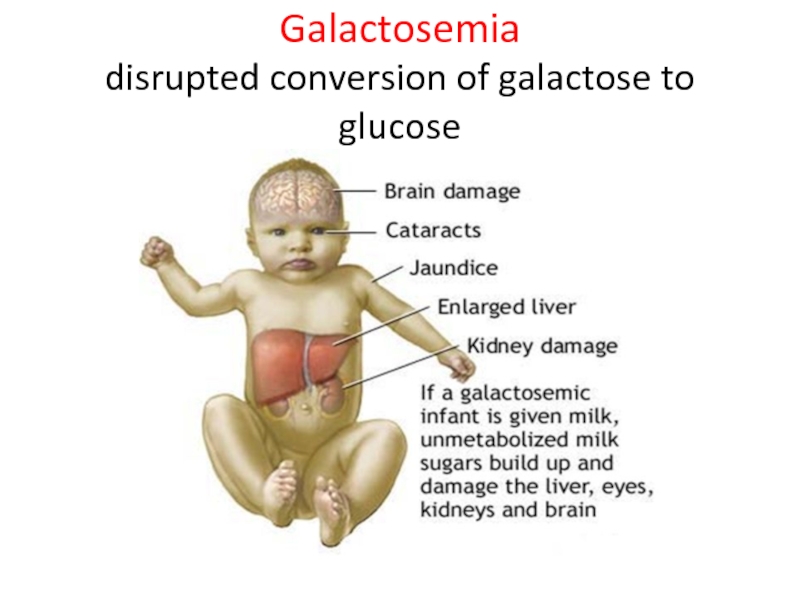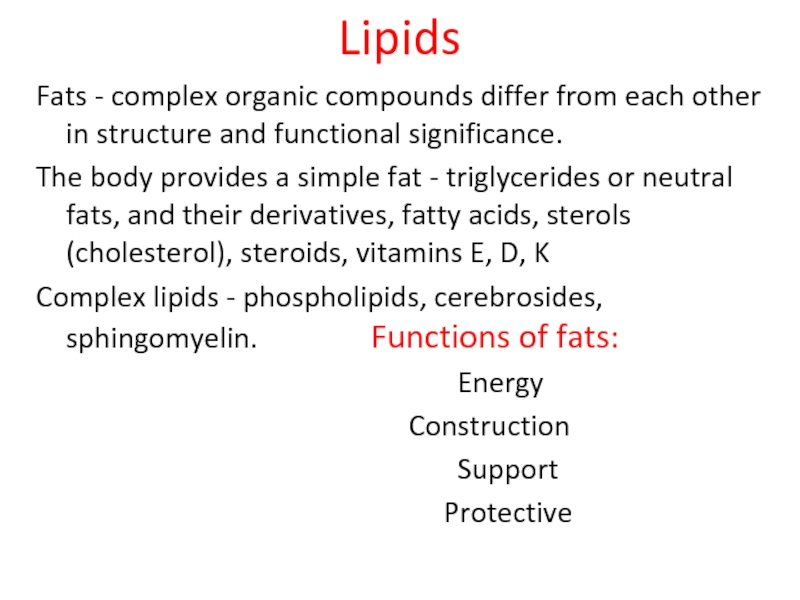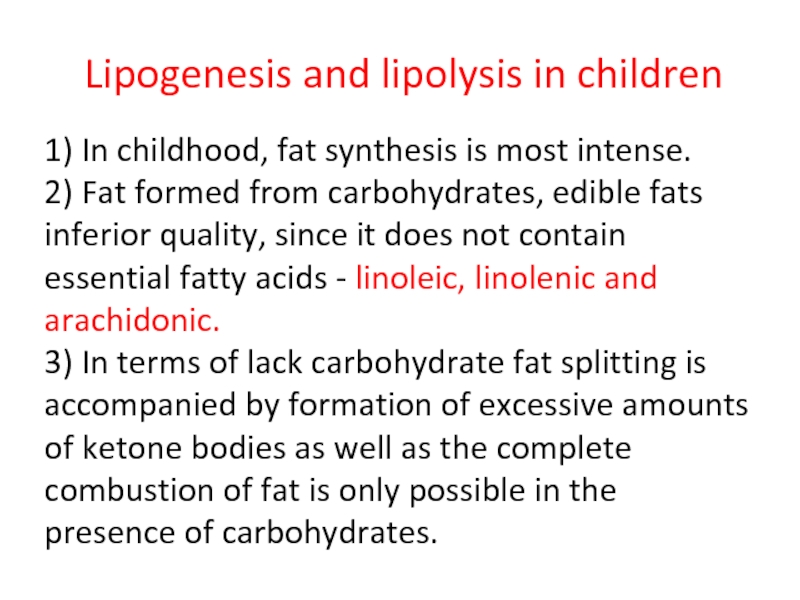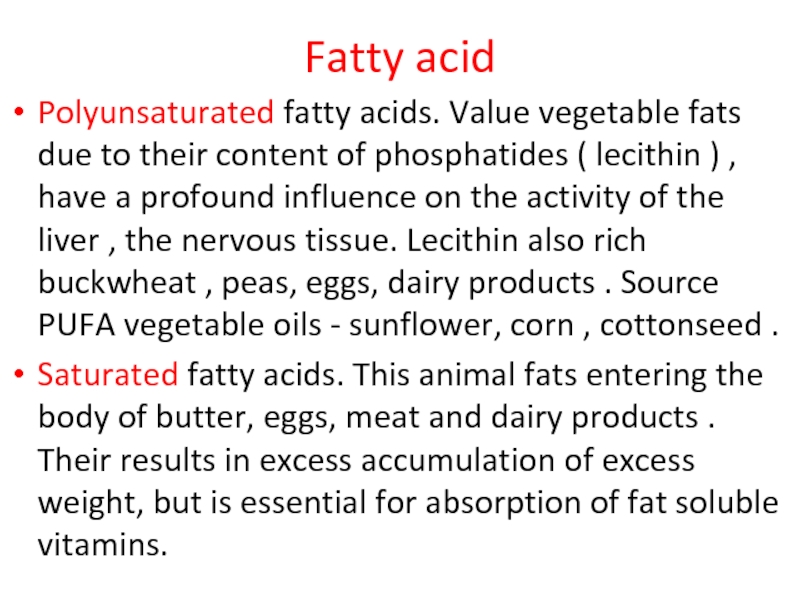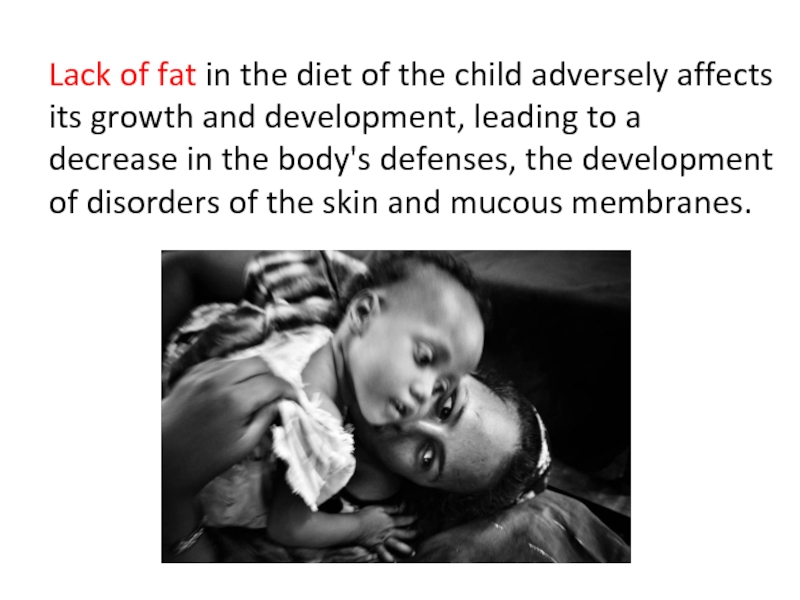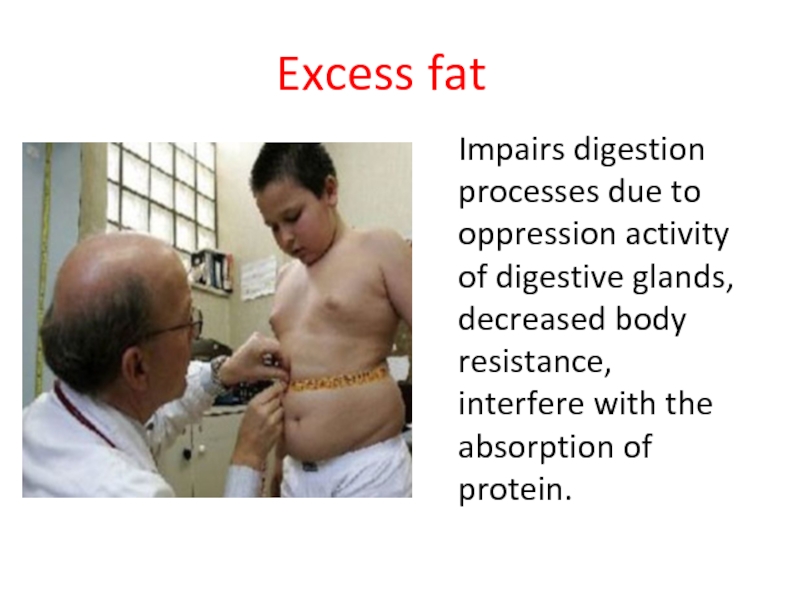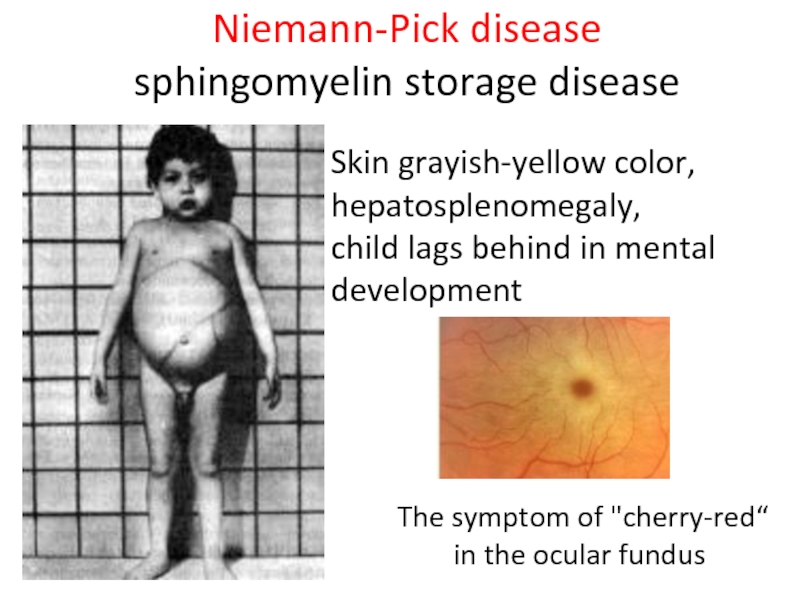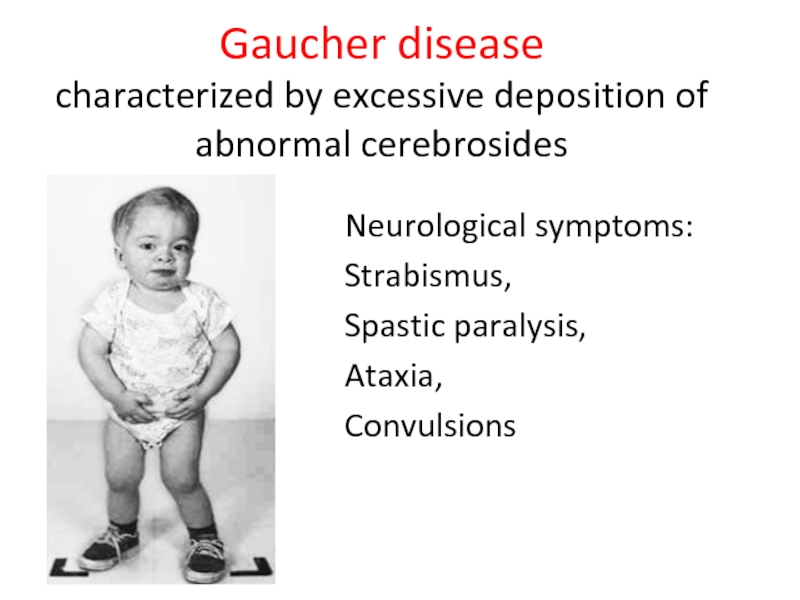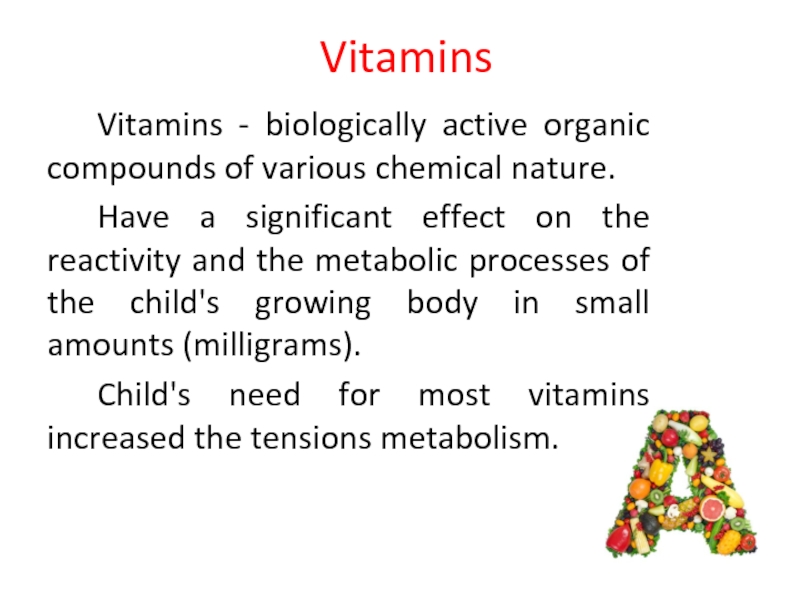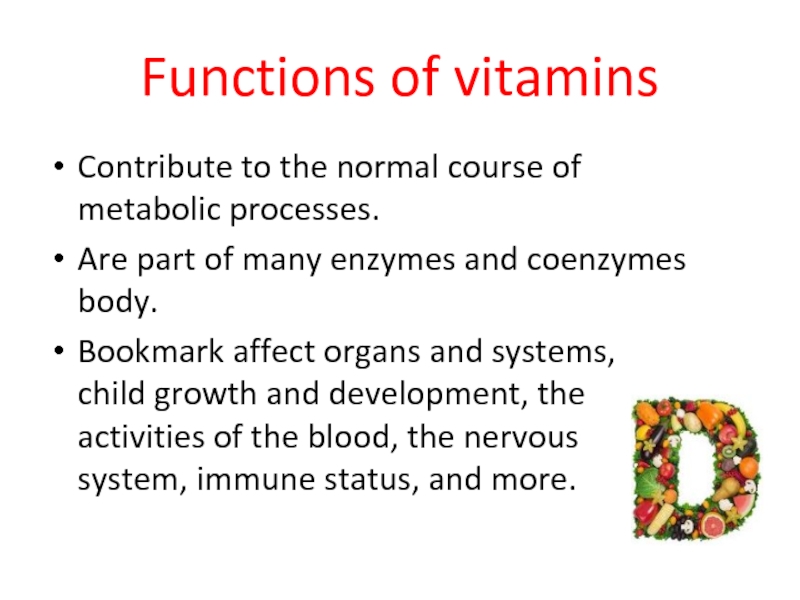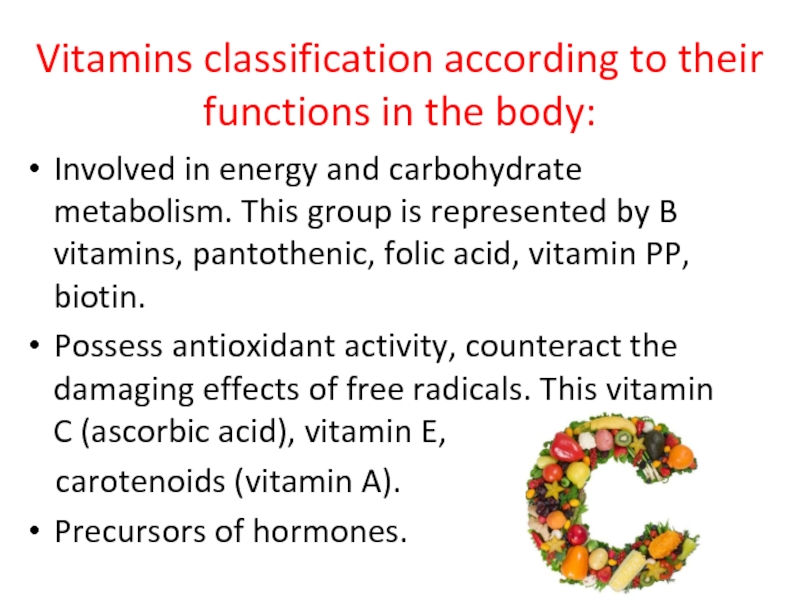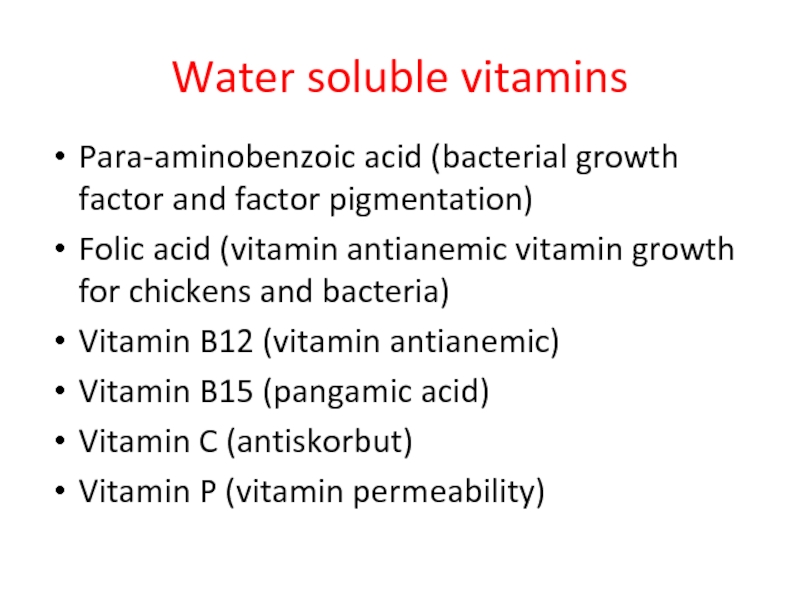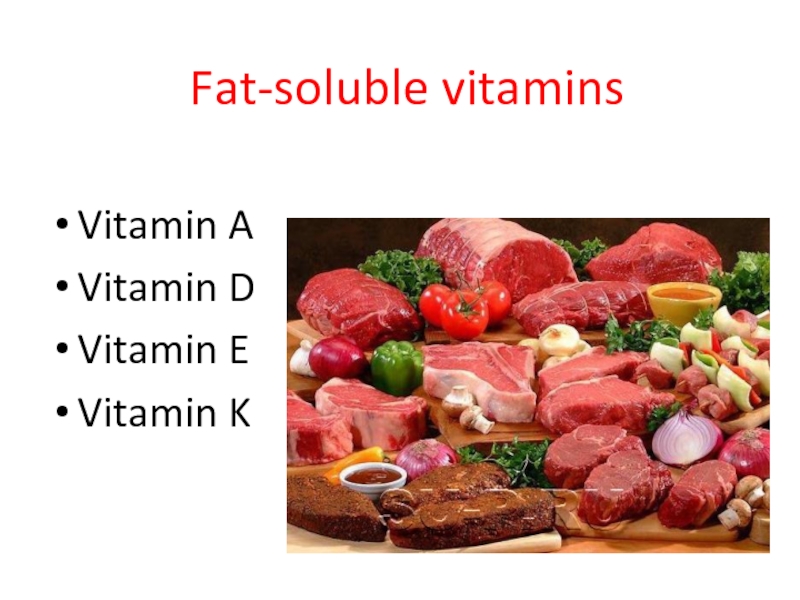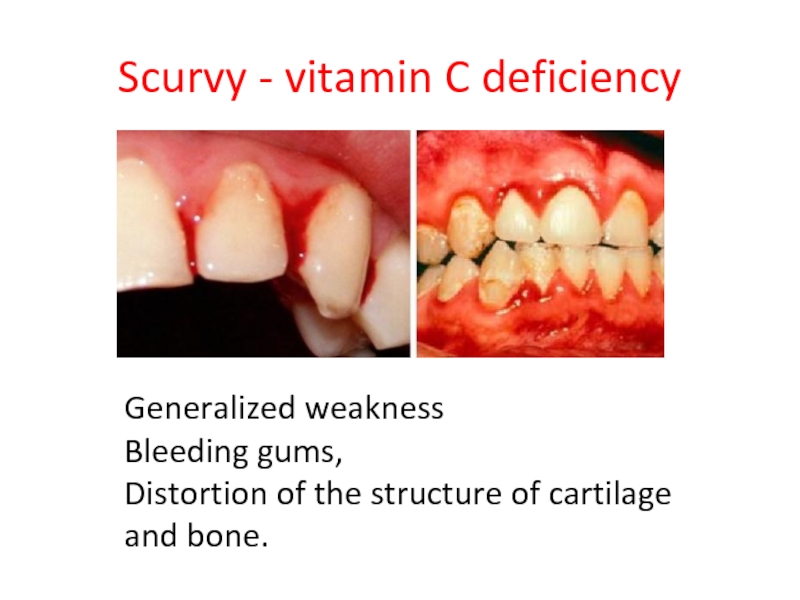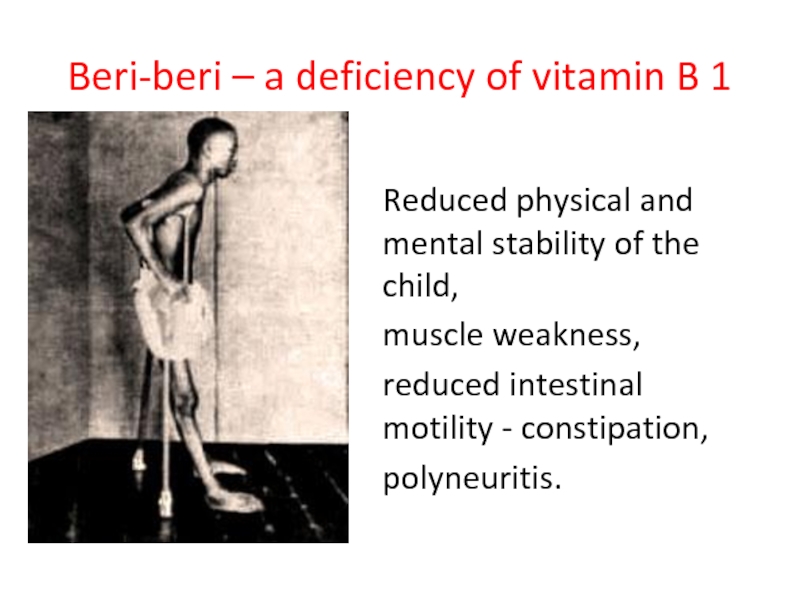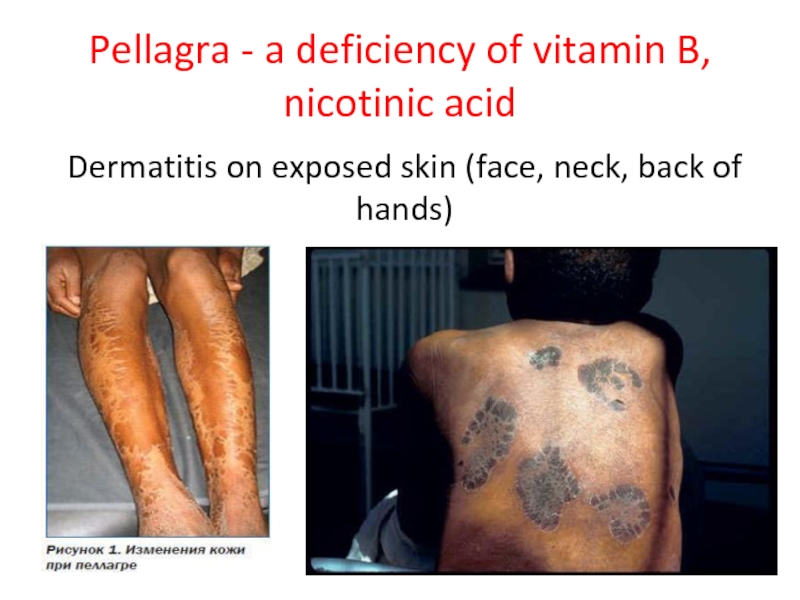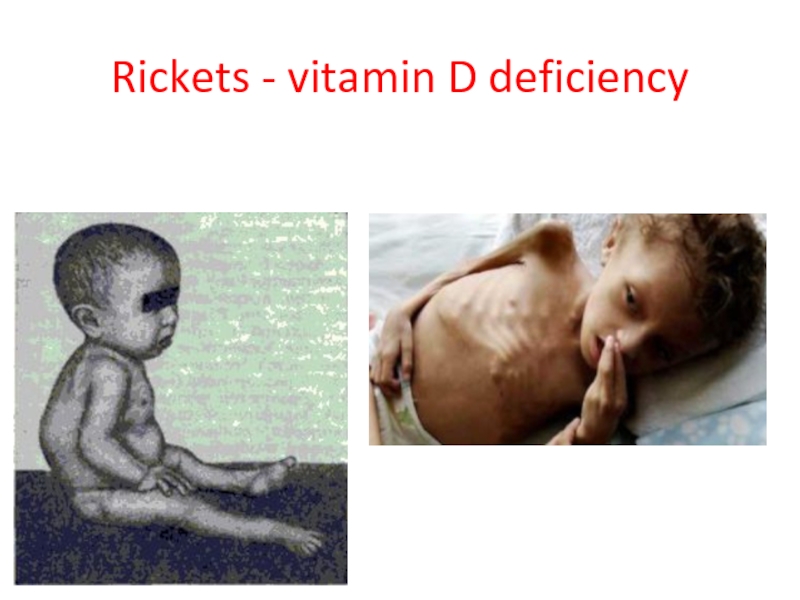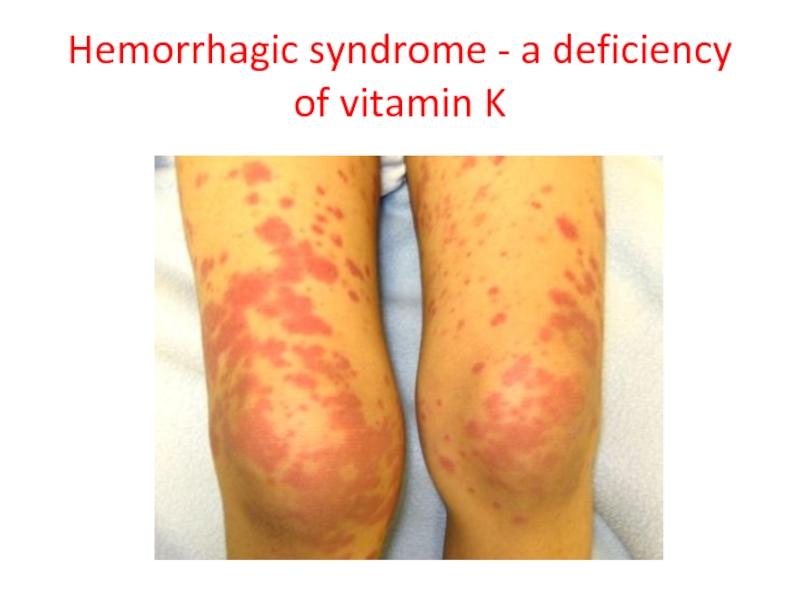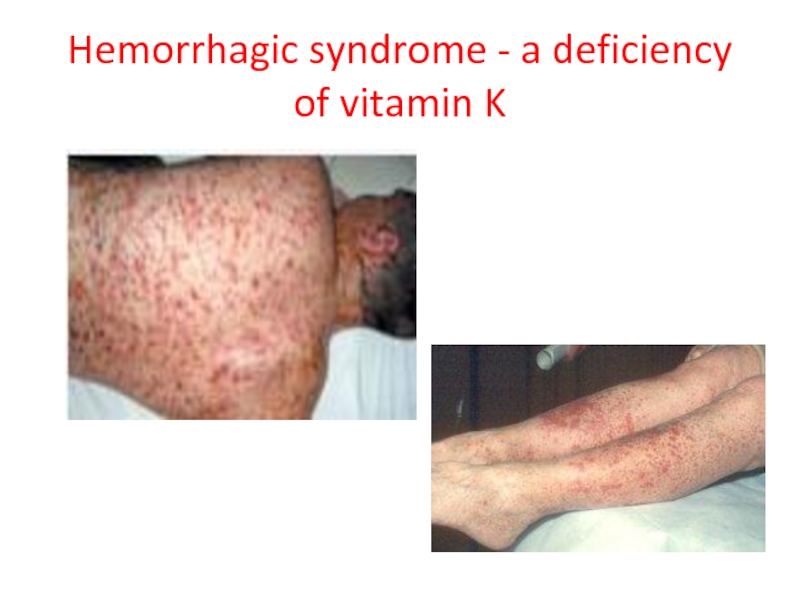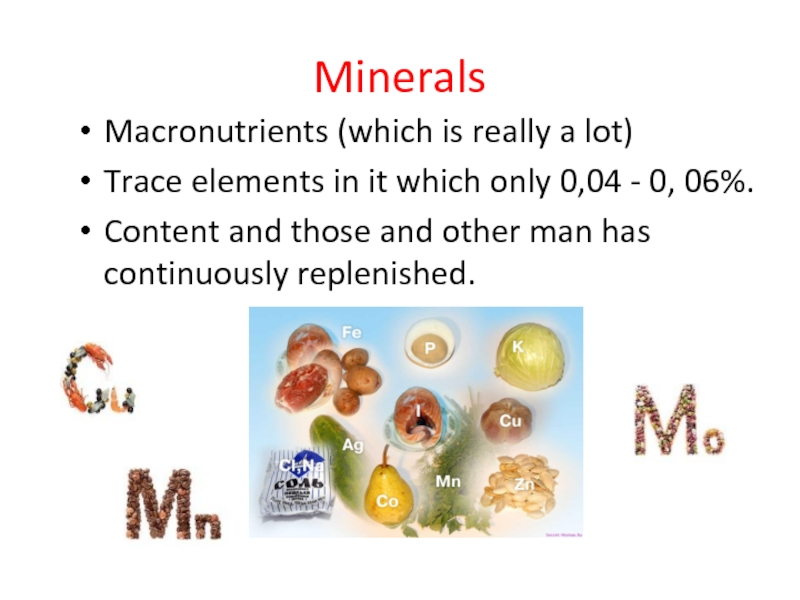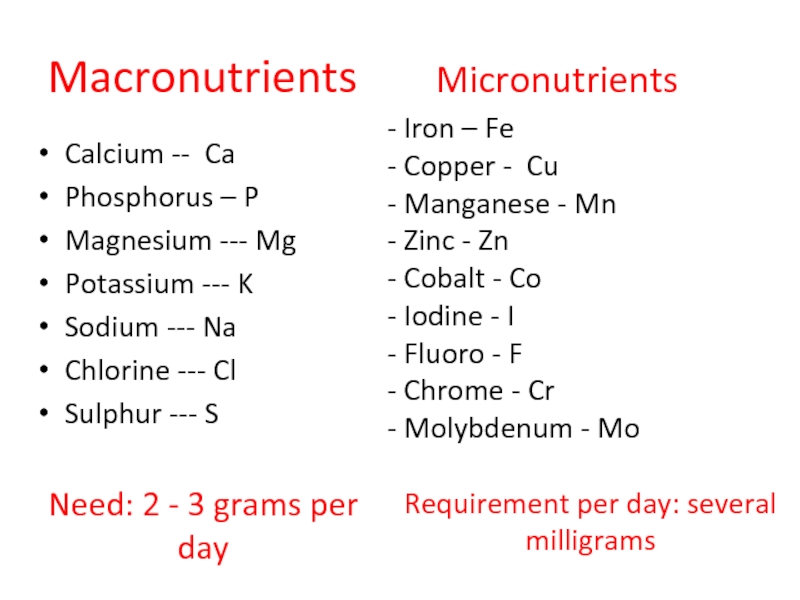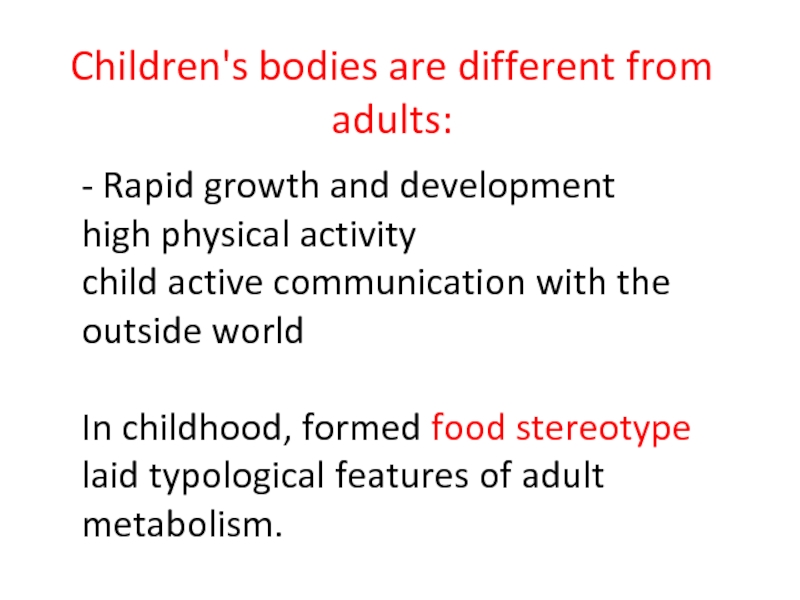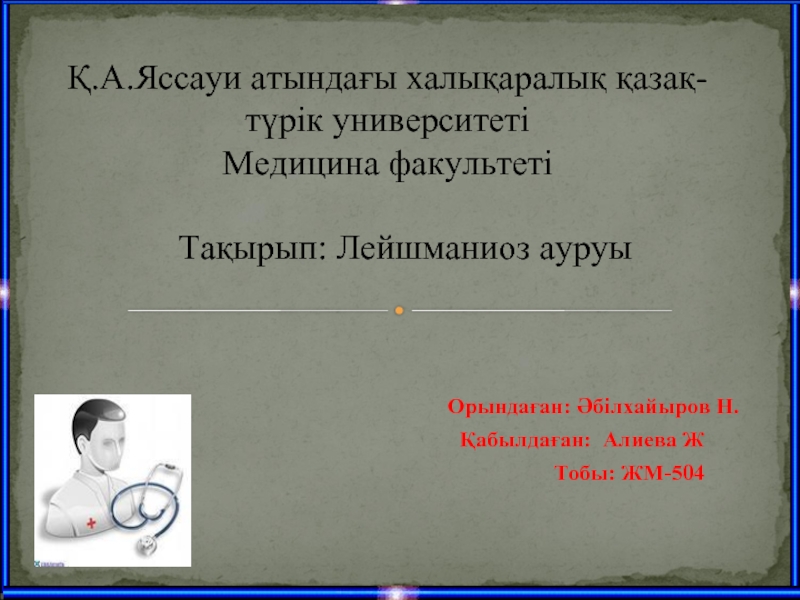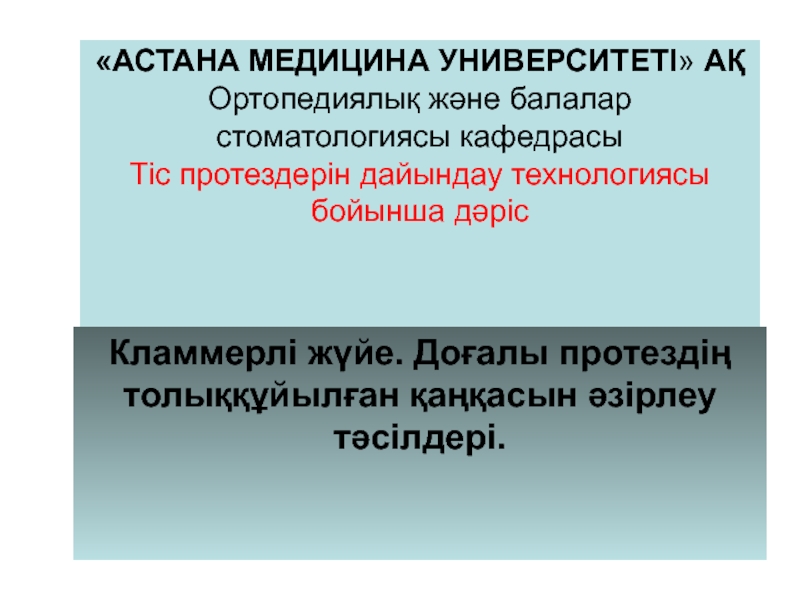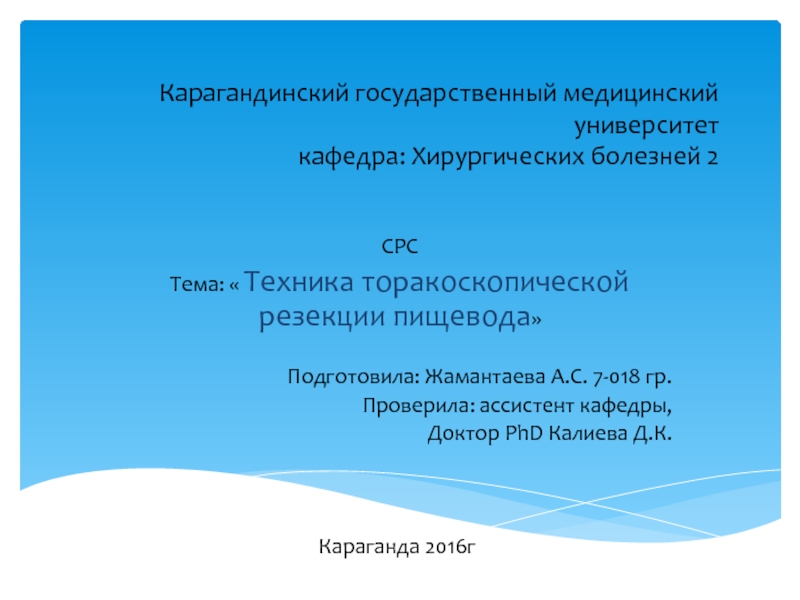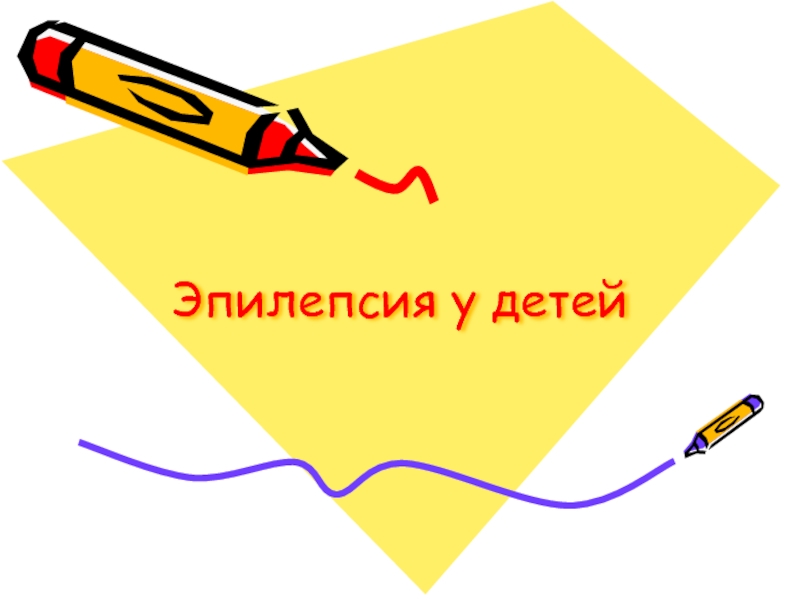- Главная
- Разное
- Дизайн
- Бизнес и предпринимательство
- Аналитика
- Образование
- Развлечения
- Красота и здоровье
- Финансы
- Государство
- Путешествия
- Спорт
- Недвижимость
- Армия
- Графика
- Культурология
- Еда и кулинария
- Лингвистика
- Английский язык
- Астрономия
- Алгебра
- Биология
- География
- Детские презентации
- Информатика
- История
- Литература
- Маркетинг
- Математика
- Медицина
- Менеджмент
- Музыка
- МХК
- Немецкий язык
- ОБЖ
- Обществознание
- Окружающий мир
- Педагогика
- Русский язык
- Технология
- Физика
- Философия
- Химия
- Шаблоны, картинки для презентаций
- Экология
- Экономика
- Юриспруденция
The particularities of metabolism in children. Clinical semiotics презентация
Содержание
- 1. The particularities of metabolism in children. Clinical semiotics
- 2. Plan of lecture: Basal metabolism Fluid
- 3. This set of processes of transformation of
- 4. For the child's body is characterized by:
- 5. Basal metabolism in children The
- 6. Water-salt metabolism in children Features water-salt metabolism
- 7. Water in the body of the child
- 8. Water balance Water enters a child's body
- 9. Homeostasis - A set of
- 10. Depot body fluid In humans, there are
- 11. Plasma electrolytes Sodium cations - 137 to
- 12. Semiotics water and electrolyte metabolism
- 13. Children are vulnerable to loss of fluid
- 14. The main causes of the syndrome of
- 15. If vomiting occurs a significant loss of
- 17. Proteins This is one of the
- 18. Essential amino acids for children: Methionine Threonine Tryptophan Phenylalanine Valine Arginine Histidine Isoleucine Leucine Lysine
- 19. Proteins are synthesized from amino acids that
- 20. On the number of entering the body
- 21. 40% of the demand for amino acids
- 22. Protein-energy malnutrition Clinical outcomes in children with
- 23. Kwashiorkor Severe malnutrition
- 24. Nutritional marasmus Marasmus – in Greek -
- 25. Phenylketonuria - disrupted synthesis of phenylalanine to tyrosine
- 26. Gomotsistinemiya - homocysteine is an
- 27. - congenital disorder caused by deficiency
- 28. Celiac Disease
- 29. Carbohydrates - the main source of energy.
- 30. Carbohydrate metabolism In children, there is a
- 31. Carbohydrate metabolism By the time of puberty,
- 32. Carbohydrate in the body in a free
- 33. Insufficient amount of carbohydrates in the diet
- 34. Disaccharidase deficiency in children lactose intolerance (lactase
- 35. Galactosemia disrupted conversion of galactose to glucose
- 36. Fats - complex organic compounds differ from
- 37. 1) In childhood, fat synthesis is most
- 38. Fatty acid Polyunsaturated fatty acids. Value vegetable
- 39. Lack of fat in the diet of
- 40. Impairs digestion processes due to oppression activity
- 41. - This is a large group of
- 42. Niemann-Pick disease sphingomyelin storage disease Skin grayish-yellow
- 43. Gaucher disease characterized by excessive deposition of
- 44. Vitamins - biologically active organic compounds of
- 45. Functions of vitamins Contribute to the normal
- 46. Vitamins classification according to their functions in
- 47. Vitamins based on solubility are divided into
- 48. Water soluble vitamins Vitamin B1 Vitamin
- 49. Water soluble vitamins Para-aminobenzoic acid (bacterial growth
- 50. Fat-soluble vitamins Vitamin A Vitamin D Vitamin E Vitamin K
- 51. Scurvy - vitamin C deficiency Generalized weakness
- 52. Beri-beri – a deficiency of vitamin B
- 53. Pellagra - a deficiency of vitamin B,
- 54. Rickets - vitamin D deficiency
- 55. Hemorrhagic syndrome - a deficiency of vitamin K
- 56. Hemorrhagic syndrome - a deficiency of vitamin K
- 57. Minerals Macronutrients (which is really a lot)
- 58. Macronutrients Micronutrients Calcium --
- 59. - Rapid growth and development high
- 60. Thanks for your attention!
Слайд 1The particularities of metabolism in children. Clinical semiotics. M. D, Assistant Professor
Слайд 2Plan of lecture:
Basal metabolism
Fluid and electrolyte balance
Protein metabolism, protein-energy
Carbohydrate metabolism.
Fat metabolism.
Vitamins.
Слайд 3This set of processes of transformation of matter and energy that
In children, unlike adults, much of the energy consumed for the growth and plastic processes, which are especially large infants and children in the first three years of life.
Metabolism and energy
Слайд 4For the child's body is characterized by:
High tension power and oxidation
Intensive basic metabolism in all age groups.
Significant energy consumption for processes of assimilation and growth.
Imperfection of the regulation of metabolism, which determines its instability and the development of lung violations.
Uniqueness of each of the main types of exchange - protein, carbohydrate and fat.
Слайд 5Basal metabolism
in children
The primary metabolism in children varies depending
In the infant and in the first years of life there is the maximum intensity of metabolism and energy, and then there is a slight decline in basal metabolism.
Compared with the first days of life, to eighteen months metabolism increases by more than half.
Слайд 6Water-salt metabolism in children
Features water-salt metabolism in children.
Role in maintaining
Causes of dehydration in infants.
Forms of the dehydration.
Слайд 7Water in the body of the child is:
Neonates - 75% of
With age, it gradually decreases and is completed in the period of growth of 65%
In the body of water is distributed among several sectors of liquid.
In the cells (intercellular space) is 60% of the total
Extracellular water in the intercellular space and plasma, as well as part of the so-called transcellular fluid (in the spinal canal, the camera eye, gastrointestinal tract, exocrine glands, renal tubules and urinary ducts).
Слайд 8Water balance
Water enters a child's body with food and drink, as
Displayed through the water:
- Kidneys – 49%
- Evaporation of sweat, feces, urine – 49%
- Through breathing – 2%
Regulation of water and ion exchange is carried out complex neuroendocrine responses aimed at maintaining a constant volume and osmotic pressure of the extracellular sector, primarily blood plasma.
Слайд 9 Homeostasis
- A set of physical and chemical constants characterizing
An important indicator of homeostasis in children, is the concentration of hydrogen ions in blood and extracellular fluids.
Слайд 10Depot body fluid
In humans, there are three fluid depot:
1) bloodstream
2) intercellular space with a certain amount of intercellular or interstitial, liquid
Note: The blood plasma and interstitial fluid together form a so-called extracellular depot, or extracellular, the liquid.
3) intracellular liquid.
Слайд 11Plasma electrolytes
Sodium cations - 137 to 145 mmol / L and
Chlorine anions - 92-107 mmol / L as determined by the osmotic pressure of the extracellular fluid.
Calcium - 5 mmol / L plasma .
Sodium bicarbonate - blood pH 7.35-7.45.
Electrolytes cytoplasm
Potassium - 120-140 mmol / L potassium in the cells.
Phosphate ions.
Слайд 12Semiotics water and electrolyte metabolism
All violations of water exchange
hyperhydration characterized by excess fluid in the body content;
dehydration - is to reduce the total volume of liquid.
Слайд 13Children are vulnerable to loss of fluid (water) in connection with:
Significant
Especially easy to create water shortages in the body of the child in the stomach and intestine diseases (acute gastroenteritis).
Under normal conditions, a large number of children fluid released into the gastrointestinal tract from digestive juices (saliva, gastric, pancreatic and intestinal secretions).
Слайд 14The main causes of the syndrome of dehydration are:
Incoming water deficit
pathological loss (vomiting, diarrhea, excessive sweating with fever, the evaporation of water at rapid breathing, rapid diuresis in diabetes, bleeding).
a combination of reasons.
Слайд 15If vomiting occurs a significant loss of water from the gastric
When diarrhea occurs hypotonic fluid loss due to increased secretion of digestive juice with a significant loss of water and ions, potassium, sodium, magnesium, bicarbonate.
Causes of dehydration
Слайд 16 Dehydration - Sunken fontanel large
Слайд 17 Proteins
This is one of the basic and vital products in
The biological value protein is determined by amino acid composition and their ability to hydrolysis by the enzymes of the digestive tract.
Слайд 18Essential amino acids for children:
Methionine
Threonine
Tryptophan
Phenylalanine
Valine
Arginine
Histidine
Isoleucine
Leucine
Lysine
Слайд 19Proteins are synthesized from amino acids that enter the body with
In the body breaks down protein synthesis, amino acids are not essential if ingested in the diet.
In the absence of essential amino acids in the diet, they can be synthesized from the essential.
For example, the lack of lysine in the diet leads to stunted growth, depletion of the muscular system, the lack of valine - balance disorders in children.
Слайд 20 On the number of entering the body and destroyed it proteins
The younger the body, the higher the positive balance and the ability to detain food nitrogen.
1 year - 4.8 g
1-3 years - 4-4.5 g
6-10 years - 2.5-3 g
12 or more - 2.5 g
adults - 1.5-1.8 g
The daily requirement of protein per 1 kg of body weight of the child:
Слайд 2140% of the demand for amino acids should be borne by
tryptophan : lysine (methionine + cysteine) = 1: 3: 3
Children need more than adults, the protein of animal origin.
As insufficient and excessive protein intake in the diet of children adversely affects their growth and psychomotor development.
Слайд 22Protein-energy malnutrition
Clinical outcomes in children with chronic malnutrition typically include short
And also: reduced physical activity,
mental apathy,
psychomotor delay and mental development
Слайд 24Nutritional marasmus
Marasmus – in Greek - depletion, extinction. It is a
Слайд 26 Gomotsistinemiya - homocysteine is an intermediate degradation product of methionine and
Слайд 27 - congenital disorder caused by deficiency of enzymes that break
Celiac Disease
The disease manifests itself more with the introduction of semolina porridge and oatmeal. The child says:
copious frothy stools, anorexia, vomiting, symptoms of dehydration, a false picture of ascites. Develop severe dystrophy.
Слайд 29 Carbohydrates - the main source of energy.
Carbohydrates enter the body
Plastic material, carbohydrates are included in the ground substance of connective tissue in the form of mucopolysaccharides forming cell membrane.
Carbohydrate metabolism
Слайд 30Carbohydrate metabolism
In children, there is a physiological tendency to ketosis, in
Слайд 31Carbohydrate metabolism
By the time of puberty, the energy consumption for basal
Слайд 32 Carbohydrate in the body in a free state and in connection
A significant role is played in the biosynthesis of carbohydrates nucleic acids, formation of blood group specificity, immunological and other processes
Carbohydrate metabolism
Слайд 33Insufficient amount of carbohydrates in the diet leads to impaired child
If excessive use of carbohydrates occurs increased formation of fat that is deposited in the subcutaneous tissue. With increased amounts of carbohydrates lowers your resistance to infectious agents child, there is a possibility of developing diabetes.
Disturbed carbohydrate intake with food:
Слайд 34Disaccharidase deficiency in children
lactose intolerance (lactase deficiency)
Clinical symptoms:
- flatulence
-
- development of malnutrition
Слайд 36Fats - complex organic compounds differ from each other in structure
The body provides a simple fat - triglycerides or neutral fats, and their derivatives, fatty acids, sterols (cholesterol), steroids, vitamins E, D, K
Complex lipids - phospholipids, cerebrosides, sphingomyelin. Functions of fats:
Energy
Construction
Support
Protective
Lipids
Слайд 371) In childhood, fat synthesis is most intense.
2) Fat formed
3) In terms of lack carbohydrate fat splitting is accompanied by formation of excessive amounts of ketone bodies as well as the complete combustion of fat is only possible in the presence of carbohydrates.
Lipogenesis and lipolysis in children
Слайд 38Fatty acid
Polyunsaturated fatty acids. Value vegetable fats due to their content
Saturated fatty acids. This animal fats entering the body of butter, eggs, meat and dairy products . Their results in excess accumulation of excess weight, but is essential for absorption of fat soluble vitamins.
Слайд 39Lack of fat in the diet of the child adversely affects
Слайд 40Impairs digestion processes due to oppression activity of digestive glands, decreased
interfere with the absorption of protein.
Excess fat
Слайд 41- This is a large group of inherited or acquired disorders
Lipidoses
Слайд 42Niemann-Pick disease
sphingomyelin storage disease
Skin grayish-yellow color,
hepatosplenomegaly,
child lags behind in
The symptom of "cherry-red“
in the ocular fundus
Слайд 43Gaucher disease
characterized by excessive deposition of abnormal cerebrosides
Neurological symptoms:
Strabismus,
Spastic paralysis,
Ataxia,
Convulsions
Слайд 44 Vitamins - biologically active organic compounds of various chemical nature.
Have
Child's need for most vitamins increased the tensions metabolism.
Vitamins
Слайд 45Functions of vitamins
Contribute to the normal course of metabolic processes.
Are
Bookmark affect organs and systems, child growth and development, the activities of the blood, the nervous system, immune status, and more.
Слайд 46Vitamins classification according to their functions in the body:
Involved in energy
Possess antioxidant activity, counteract the damaging effects of free radicals. This vitamin C (ascorbic acid), vitamin E,
carotenoids (vitamin A).
Precursors of hormones.
Слайд 47Vitamins based on solubility are divided into groups:
1) Fat-soluble - A,
2) Water soluble - C, P, B, etc.
3) Vitamin-compound - bioflavonoids, choline, inositol, lipoic acid, and others.
Слайд 48Water soluble vitamins
Vitamin B1
Vitamin B2
Vitamin PP
Vitamin B6
Pantothenic
Biotin (vitamin H)
Inositol
Слайд 49Water soluble vitamins
Para-aminobenzoic acid (bacterial growth factor and factor pigmentation)
Folic
Vitamin B12 (vitamin antianemic)
Vitamin B15 (pangamic acid)
Vitamin C (antiskorbut)
Vitamin P (vitamin permeability)
Слайд 51Scurvy - vitamin C deficiency
Generalized weakness
Bleeding gums,
Distortion of the
Слайд 52Beri-beri – a deficiency of vitamin B 1
Reduced physical and mental
muscle weakness,
reduced intestinal motility - constipation,
polyneuritis.
Слайд 53Pellagra - a deficiency of vitamin B, nicotinic acid
Dermatitis on exposed
Слайд 57Minerals
Macronutrients (which is really a lot)
Trace elements in it which
Content and those and other man has continuously replenished.
Слайд 58Macronutrients Micronutrients
Calcium -- Ca
Phosphorus – P
Magnesium ---
Potassium --- K
Sodium --- Na
Chlorine --- Cl
Sulphur --- S
Need: 2 - 3 grams per day
- Iron – Fe
- Copper - Cu
- Manganese - Mn
- Zinc - Zn
- Cobalt - Co
- Iodine - I
- Fluoro - F
- Chrome - Cr
- Molybdenum - Mo
Requirement per day: several milligrams
Слайд 59- Rapid growth and development
high physical activity
child active communication
In childhood, formed food stereotype laid typological features of adult metabolism.
Children's bodies are different from adults:
